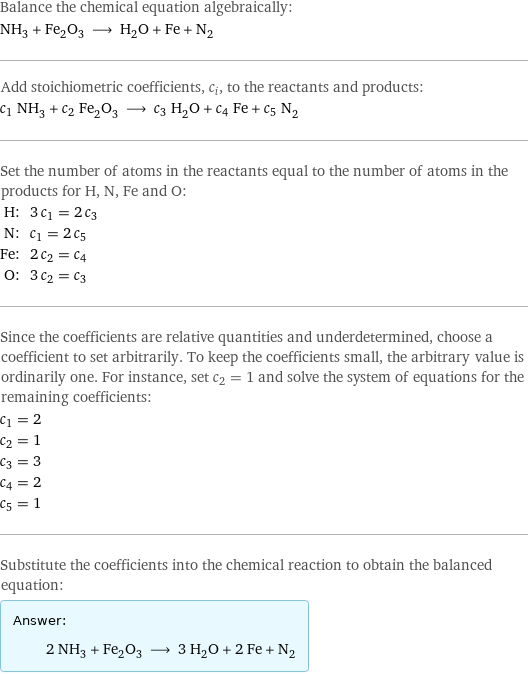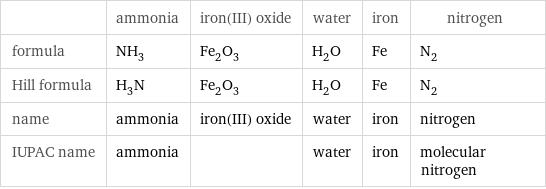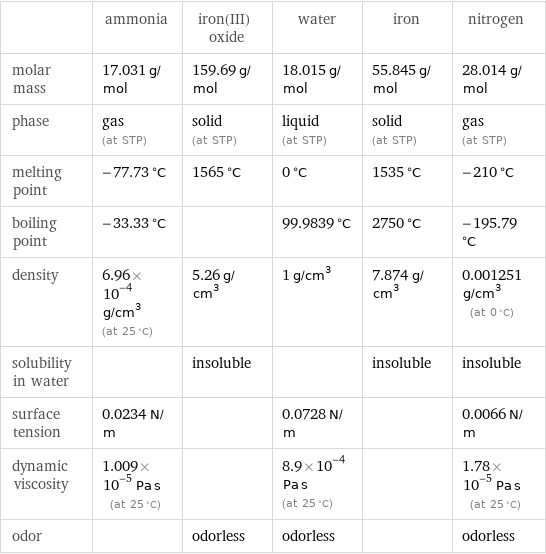Input interpretation

NH_3 ammonia + Fe_2O_3 iron(III) oxide ⟶ H_2O water + Fe iron + N_2 nitrogen
Balanced equation

Balance the chemical equation algebraically: NH_3 + Fe_2O_3 ⟶ H_2O + Fe + N_2 Add stoichiometric coefficients, c_i, to the reactants and products: c_1 NH_3 + c_2 Fe_2O_3 ⟶ c_3 H_2O + c_4 Fe + c_5 N_2 Set the number of atoms in the reactants equal to the number of atoms in the products for H, N, Fe and O: H: | 3 c_1 = 2 c_3 N: | c_1 = 2 c_5 Fe: | 2 c_2 = c_4 O: | 3 c_2 = c_3 Since the coefficients are relative quantities and underdetermined, choose a coefficient to set arbitrarily. To keep the coefficients small, the arbitrary value is ordinarily one. For instance, set c_2 = 1 and solve the system of equations for the remaining coefficients: c_1 = 2 c_2 = 1 c_3 = 3 c_4 = 2 c_5 = 1 Substitute the coefficients into the chemical reaction to obtain the balanced equation: Answer: | | 2 NH_3 + Fe_2O_3 ⟶ 3 H_2O + 2 Fe + N_2
Structures

+ ⟶ + +
Names

ammonia + iron(III) oxide ⟶ water + iron + nitrogen
Reaction thermodynamics
Enthalpy

| ammonia | iron(III) oxide | water | iron | nitrogen molecular enthalpy | -45.9 kJ/mol | -826 kJ/mol | -285.8 kJ/mol | 0 kJ/mol | 0 kJ/mol total enthalpy | -91.8 kJ/mol | -826 kJ/mol | -857.5 kJ/mol | 0 kJ/mol | 0 kJ/mol | H_initial = -917.8 kJ/mol | | H_final = -857.5 kJ/mol | | ΔH_rxn^0 | -857.5 kJ/mol - -917.8 kJ/mol = 60.31 kJ/mol (endothermic) | | | |
Entropy

| ammonia | iron(III) oxide | water | iron | nitrogen molecular entropy | 193 J/(mol K) | 90 J/(mol K) | 69.91 J/(mol K) | 27 J/(mol K) | 192 J/(mol K) total entropy | 386 J/(mol K) | 90 J/(mol K) | 209.7 J/(mol K) | 54 J/(mol K) | 192 J/(mol K) | S_initial = 476 J/(mol K) | | S_final = 455.7 J/(mol K) | | ΔS_rxn^0 | 455.7 J/(mol K) - 476 J/(mol K) = -20.27 J/(mol K) (exoentropic) | | | |
Equilibrium constant
![Construct the equilibrium constant, K, expression for: NH_3 + Fe_2O_3 ⟶ H_2O + Fe + N_2 Plan: • Balance the chemical equation. • Determine the stoichiometric numbers. • Assemble the activity expression for each chemical species. • Use the activity expressions to build the equilibrium constant expression. Write the balanced chemical equation: 2 NH_3 + Fe_2O_3 ⟶ 3 H_2O + 2 Fe + N_2 Assign stoichiometric numbers, ν_i, using the stoichiometric coefficients, c_i, from the balanced chemical equation in the following manner: ν_i = -c_i for reactants and ν_i = c_i for products: chemical species | c_i | ν_i NH_3 | 2 | -2 Fe_2O_3 | 1 | -1 H_2O | 3 | 3 Fe | 2 | 2 N_2 | 1 | 1 Assemble the activity expressions accounting for the state of matter and ν_i: chemical species | c_i | ν_i | activity expression NH_3 | 2 | -2 | ([NH3])^(-2) Fe_2O_3 | 1 | -1 | ([Fe2O3])^(-1) H_2O | 3 | 3 | ([H2O])^3 Fe | 2 | 2 | ([Fe])^2 N_2 | 1 | 1 | [N2] The equilibrium constant symbol in the concentration basis is: K_c Mulitply the activity expressions to arrive at the K_c expression: Answer: | | K_c = ([NH3])^(-2) ([Fe2O3])^(-1) ([H2O])^3 ([Fe])^2 [N2] = (([H2O])^3 ([Fe])^2 [N2])/(([NH3])^2 [Fe2O3])](../image_source/a9246b166bdf3345a552fbf1f0efdd94.png)
Construct the equilibrium constant, K, expression for: NH_3 + Fe_2O_3 ⟶ H_2O + Fe + N_2 Plan: • Balance the chemical equation. • Determine the stoichiometric numbers. • Assemble the activity expression for each chemical species. • Use the activity expressions to build the equilibrium constant expression. Write the balanced chemical equation: 2 NH_3 + Fe_2O_3 ⟶ 3 H_2O + 2 Fe + N_2 Assign stoichiometric numbers, ν_i, using the stoichiometric coefficients, c_i, from the balanced chemical equation in the following manner: ν_i = -c_i for reactants and ν_i = c_i for products: chemical species | c_i | ν_i NH_3 | 2 | -2 Fe_2O_3 | 1 | -1 H_2O | 3 | 3 Fe | 2 | 2 N_2 | 1 | 1 Assemble the activity expressions accounting for the state of matter and ν_i: chemical species | c_i | ν_i | activity expression NH_3 | 2 | -2 | ([NH3])^(-2) Fe_2O_3 | 1 | -1 | ([Fe2O3])^(-1) H_2O | 3 | 3 | ([H2O])^3 Fe | 2 | 2 | ([Fe])^2 N_2 | 1 | 1 | [N2] The equilibrium constant symbol in the concentration basis is: K_c Mulitply the activity expressions to arrive at the K_c expression: Answer: | | K_c = ([NH3])^(-2) ([Fe2O3])^(-1) ([H2O])^3 ([Fe])^2 [N2] = (([H2O])^3 ([Fe])^2 [N2])/(([NH3])^2 [Fe2O3])
Rate of reaction
![Construct the rate of reaction expression for: NH_3 + Fe_2O_3 ⟶ H_2O + Fe + N_2 Plan: • Balance the chemical equation. • Determine the stoichiometric numbers. • Assemble the rate term for each chemical species. • Write the rate of reaction expression. Write the balanced chemical equation: 2 NH_3 + Fe_2O_3 ⟶ 3 H_2O + 2 Fe + N_2 Assign stoichiometric numbers, ν_i, using the stoichiometric coefficients, c_i, from the balanced chemical equation in the following manner: ν_i = -c_i for reactants and ν_i = c_i for products: chemical species | c_i | ν_i NH_3 | 2 | -2 Fe_2O_3 | 1 | -1 H_2O | 3 | 3 Fe | 2 | 2 N_2 | 1 | 1 The rate term for each chemical species, B_i, is 1/ν_i(Δ[B_i])/(Δt) where [B_i] is the amount concentration and t is time: chemical species | c_i | ν_i | rate term NH_3 | 2 | -2 | -1/2 (Δ[NH3])/(Δt) Fe_2O_3 | 1 | -1 | -(Δ[Fe2O3])/(Δt) H_2O | 3 | 3 | 1/3 (Δ[H2O])/(Δt) Fe | 2 | 2 | 1/2 (Δ[Fe])/(Δt) N_2 | 1 | 1 | (Δ[N2])/(Δt) (for infinitesimal rate of change, replace Δ with d) Set the rate terms equal to each other to arrive at the rate expression: Answer: | | rate = -1/2 (Δ[NH3])/(Δt) = -(Δ[Fe2O3])/(Δt) = 1/3 (Δ[H2O])/(Δt) = 1/2 (Δ[Fe])/(Δt) = (Δ[N2])/(Δt) (assuming constant volume and no accumulation of intermediates or side products)](../image_source/a8f8656346568a993972ff39d49844fb.png)
Construct the rate of reaction expression for: NH_3 + Fe_2O_3 ⟶ H_2O + Fe + N_2 Plan: • Balance the chemical equation. • Determine the stoichiometric numbers. • Assemble the rate term for each chemical species. • Write the rate of reaction expression. Write the balanced chemical equation: 2 NH_3 + Fe_2O_3 ⟶ 3 H_2O + 2 Fe + N_2 Assign stoichiometric numbers, ν_i, using the stoichiometric coefficients, c_i, from the balanced chemical equation in the following manner: ν_i = -c_i for reactants and ν_i = c_i for products: chemical species | c_i | ν_i NH_3 | 2 | -2 Fe_2O_3 | 1 | -1 H_2O | 3 | 3 Fe | 2 | 2 N_2 | 1 | 1 The rate term for each chemical species, B_i, is 1/ν_i(Δ[B_i])/(Δt) where [B_i] is the amount concentration and t is time: chemical species | c_i | ν_i | rate term NH_3 | 2 | -2 | -1/2 (Δ[NH3])/(Δt) Fe_2O_3 | 1 | -1 | -(Δ[Fe2O3])/(Δt) H_2O | 3 | 3 | 1/3 (Δ[H2O])/(Δt) Fe | 2 | 2 | 1/2 (Δ[Fe])/(Δt) N_2 | 1 | 1 | (Δ[N2])/(Δt) (for infinitesimal rate of change, replace Δ with d) Set the rate terms equal to each other to arrive at the rate expression: Answer: | | rate = -1/2 (Δ[NH3])/(Δt) = -(Δ[Fe2O3])/(Δt) = 1/3 (Δ[H2O])/(Δt) = 1/2 (Δ[Fe])/(Δt) = (Δ[N2])/(Δt) (assuming constant volume and no accumulation of intermediates or side products)
Chemical names and formulas

| ammonia | iron(III) oxide | water | iron | nitrogen formula | NH_3 | Fe_2O_3 | H_2O | Fe | N_2 Hill formula | H_3N | Fe_2O_3 | H_2O | Fe | N_2 name | ammonia | iron(III) oxide | water | iron | nitrogen IUPAC name | ammonia | | water | iron | molecular nitrogen
Substance properties

| ammonia | iron(III) oxide | water | iron | nitrogen molar mass | 17.031 g/mol | 159.69 g/mol | 18.015 g/mol | 55.845 g/mol | 28.014 g/mol phase | gas (at STP) | solid (at STP) | liquid (at STP) | solid (at STP) | gas (at STP) melting point | -77.73 °C | 1565 °C | 0 °C | 1535 °C | -210 °C boiling point | -33.33 °C | | 99.9839 °C | 2750 °C | -195.79 °C density | 6.96×10^-4 g/cm^3 (at 25 °C) | 5.26 g/cm^3 | 1 g/cm^3 | 7.874 g/cm^3 | 0.001251 g/cm^3 (at 0 °C) solubility in water | | insoluble | | insoluble | insoluble surface tension | 0.0234 N/m | | 0.0728 N/m | | 0.0066 N/m dynamic viscosity | 1.009×10^-5 Pa s (at 25 °C) | | 8.9×10^-4 Pa s (at 25 °C) | | 1.78×10^-5 Pa s (at 25 °C) odor | | odorless | odorless | | odorless
Units
